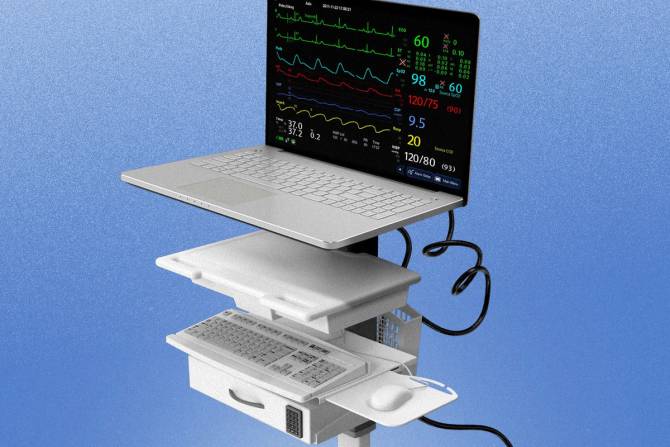Happy Monday! In honor of National Straw Hat Day—and definitely not the fact that some of us at Healthcare Brew just got our first sunburns of 2023—we’re tipping our hats to the timeless sun-protective wardrobe staple. If hats aren’t your thing, we (and many dermatologists) recommend wearing sunscreen with an SPF of at least 30.
In today’s edition:
 ️ Concierge docs ️ Concierge docs
 Best cybersecurity practices Best cybersecurity practices
 Transportation access Transportation access
—Maia Anderson, Kristine White, Shannon Young
|
|
Fstop123/Getty Images
The Covid-19 pandemic hit every aspect of healthcare, and primary care practices were no exception.
Most physician practices make money through the fee-for-service business model, which pays physicians based on the number of services they provide. But with Covid, “suddenly that fee-for-service care dropped off substantially, so many practices were in threat of closing,” Russ Phillips, director of Harvard Medical School’s Center for Primary Care, told Healthcare Brew.
Primary care—which was a $260 billion industry in 2022—lost about $15 billion in 2020, according to an article from Phillips and other Harvard researchers. In the same period, approximately 16,000 physician practices closed, according to a survey from the Physicians Foundation.
Now, the financial pressures the pandemic exacerbated are forcing many practices to switch business models to stay viable—and two are emerging as the favorites: concierge and direct primary care (DPC) models. “I feel like almost every care-delivery-oriented client or organization that we work with is fundamentally rethinking their business,” Abby Johnson, leader of EY Americas’ health consulting practice, told Healthcare Brew.
Concierge vs. direct primary care. Under a concierge business model, practices charge an annual fee for patients to become members (not accounting for the cost of care often covered by insurance). Those fees could cost as much as $10,000 per year, according to Phillips, though membership comes with benefits like being able to reach a physician via phone at any time and same-day appointments.
Under the DPC model, practices don’t accept insurance and patients pay a lower monthly fee, ranging from around $50 to a few hundred dollars per month, for direct access to their doctor and unlimited office visits, as well as the option to sidestep high insurance deductibles. But patients would likely still need to keep their insurance to cover healthcare services that fall outside the scope of primary care.
Keep reading here.—MA
Do you work in healthcare or have information about the industry that we should know? Email Maia at [email protected]. For completely confidential conversations, ask Maia for her number on Signal.
|
|
We haven’t figured out a way to unplug from life’s stresses when we hit the hay—yet. We just deal with ’em in a different way. Bruxism, aka grinding or clenching your teeth while you sleep, can cause major damage to your smile, your sleep, and your well-being.
But dentists have spoken: Remi’s night guards strike the balance between cost effective and teeth protective. Instead of settling for a $500+ night guard from a dental office, Remi offers custom guards at 80% less than what dentists charge.
Each night guard is made in Remi’s own lab by a highly skilled team of dental pros. And with their at-home kit, you can get your perfect fit without needing to take a trip to the dentist.
Protect your smile with Remi. Get your custom guard with a 45-Night Perfect Fit Guarantee.
|
|
Amelia Kinsinger
Health systems are increasingly reactive—rather than proactive—when it comes to cybersecurity threats, an April study from Censinet, KLAS Research, and the American Hospital Association (AHA) found.
The study, which analyzed responses from 48 healthcare organizations ranging in size, assessed how well the industry aligned with National Institute of Standards and Technology (NIST) and Health Industry Cybersecurity Practices (HICP) guidelines.
Some of these metrics include identifying, responding to, and recovering from cybersecurity incidents.
While healthcare organizations showed strong email systems protections, they lagged behind when it came to medical device cybersecurity safeguards, per the study. There have been at least 123 data breaches at healthcare providers in 2023 so far, according to data from the Department of Health and Human Services.
“The Healthcare Cybersecurity Benchmarking Study initiative provides critical intelligence to help guide our fight against those who directly threaten hospital operations and patient care,” AHA National Advisor for Cybersecurity and Risk John Riggi said in a statement.
More than half of the organizations surveyed reported 100% coverage on most of the HCIP metrics falling under email system protections, according to the study.
Email phishing scams are one of the common ways that “bad actors” get past a health system’s security in a ransomware attack, cyber-risk monitoring platform Black Kite Chief Security Officer Bob Maley told Healthcare Brew in March.
Average cybersecurity coverage on medical devices, on the other hand, was just 54%, representing an “industry-wide vulnerability,” according to the study. The FDA released guidance in March requiring manufacturers of all new medical devices to “monitor, identify, and address” cybersecurity vulnerabilities.
Preventing a cybersecurity attack, which can cost health systems an average of $10 million, can be easier than recovering from one, Maley said.
Keep reading here.—KW
Do you work in healthcare or have information about the industry that we should know? Email Kristine at [email protected]. For completely confidential conversations, ask Kristine for her number on Signal.
|
|
Maskot/Getty Images
Policymakers looking to improve healthcare outcomes in rural parts of the US may want to rethink strategies that focus on luring doctors to those areas and instead create subsidies to connect patients with care in larger cities, new research suggests.
A March research brief from the University of Chicago’s Becker Friedman Institute, which analyzed Medicare claims data from 2017, found that adding more doctors and health providers in rural areas—a key health equity strategy for many policymakers—could help patients in need of emergency care or time-sensitive services. But additional providers may not be enough to bridge the rural-urban divide in care quality and patient outcomes—particularly when it comes to specialty care.
“Even if care is moved to rural areas, those hospitals can’t attain the same levels of specialization, expertise, and experience that we see in larger markets,” said Joshua Gottlieb, a health economist and associate professor with the University of Chicago Harris School of Public Policy, who worked on the report.
Lawmakers should instead focus on improving transportation affordability and access so more patients can travel to cities for healthcare services—rather than incentives, like student loan forgiveness, for doctors who relocate to rural areas, the researchers argued.
Many patients in smaller markets are already traveling for care.
According to the report, more than one-fifth of US healthcare consumption involves patients who travel to a different region for services. Those rates can be even higher when it comes to uncommon, specialty procedures.
Half of patients who received left ventricular assist devices, for example, came from different regions than the surgeon for the rare cardiac procedure, researchers found. By contrast, just 15% of patients getting routine colonoscopy screenings traveled outside their home regions.
Still, a patient’s willingness to travel for medical care is often tied to their socioeconomic status, researchers noted.
Keep reading here.—SY
Do you work in healthcare or have information about the industry that we should know? Email Shannon at [email protected]. For completely confidential conversations, ask Shannon for her number on Signal.
|
|
Francis Scialabba
Today’s top healthcare reads.
Stat: Eighty-three percent of consumers surveyed in 2021 said they used a disinfectant wipe in the last week. New research indicates those wipes might be harmful. (The Guardian)
Quote: “My radar went up immediately.”—Avrom Caplan, an assistant professor of dermatology at NYU Grossman School of Medicine, who treated a drug-resistant ringworm infection in a patient who had traveled from Bangladesh (NBC News)
Read: MSG might be the secret ingredient to help cut down on salt intake. (The Atlantic)
|
|
-
Monkeypox is no longer a global health emergency, though cases are still spreading in the US.
-
Public health experts will still test wastewater for Covid, despite the public health emergency ending.
-
Two medical professionals who work in Boston and Houston weighed the pros and cons of using online mental health services.
-
Washington State reported that its flu death rate increased tenfold in 2022–23, making it the deadliest season in five years.
|
|
Catch up on the top Healthcare Brew stories you may have missed:
|
|
|
Written by
Maia Anderson, Kristine White, and Shannon Young
Was this email forwarded to you? Sign up
here.
{if !contains(profile.lists,"Marketing Brew") || !contains(profile.lists,"CFO Brew") || !contains(profile.lists,"HR Brew") || !contains(profile.lists,"EmTech Brew") || !contains(profile.lists,"IT Brew") || !contains(profile.lists,"Retail Brew") || !contains(profile.lists,"Healthcare Brew")}
Take The Brew to work
{/if}
{if !contains(profile.lists,"Marketing Brew")}
-
Marketers:
{if !contains(profile.lists,"Marketing Brew")}
Marketing Brew
{/if}
{/if}
{if !contains(profile.lists,"CFO Brew") || !contains(profile.lists,"HR Brew")}
-
Corporate:
{if !contains(profile.lists,"CFO Brew")}
CFO Brew
{/if}
{if !contains(profile.lists,"HR Brew")}
HR Brew
{/if}
{/if}
{if !contains(profile.lists,"EmTech Brew") || !contains(profile.lists,"IT Brew")}
-
Tech:
{if !contains(profile.lists,"IT Brew")}
IT Brew
{/if}
{if !contains(profile.lists,"EmTech Brew")}
Tech Brew
{/if}
{/if}
{if !contains(profile.lists,"Retail Brew")}
-
Retailers:
Retail Brew
{/if}
{if !contains(profile.lists,"Healthcare Brew")}
-
Healthcare:
Healthcare Brew
{/if}
{if !contains(profile.lists,"Daily Business") || !contains(profile.lists,"Money Scoop") || !contains(profile.lists,"Money With Katie")}
Get smarter in just 5 minutes
{/if}
{if !contains(profile.lists,"Daily Business")}
-
Business News:
Morning Brew
{/if}
{if !contains(profile.lists,"Money Scoop") || !contains(profile.lists,"Money With Katie") || !contains(profile.lists,"Raise")}
-
Money & Career:
{if !contains(profile.lists,"Money Scoop")}
Money Scoop
{/if}
{if !contains(profile.lists,"Money With Katie")}
Money With Katie
{/if}
{if !contains(profile.lists,"Raise")}
Raise
{/if}
{/if}
Business education without the BS
Interested in podcasts?
|
ADVERTISE
//
CAREERS
//
SHOP
//
FAQ
Update your email preferences or unsubscribe
here.
View our privacy policy
here.
Copyright ©
2023
Morning Brew. All rights reserved.
22 W 19th St, 4th Floor, New York, NY 10011
|
|








